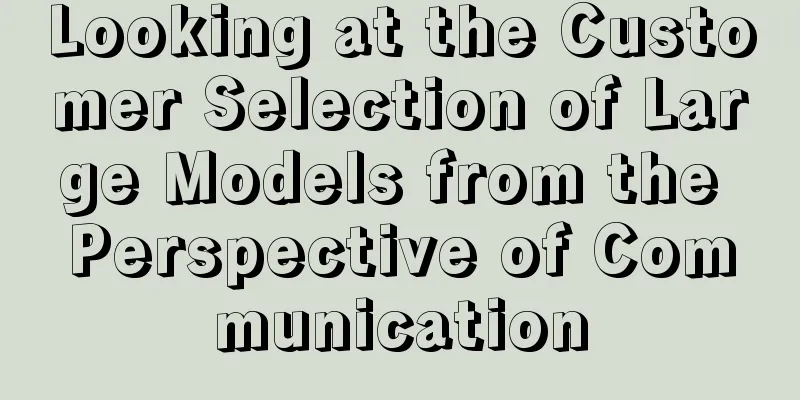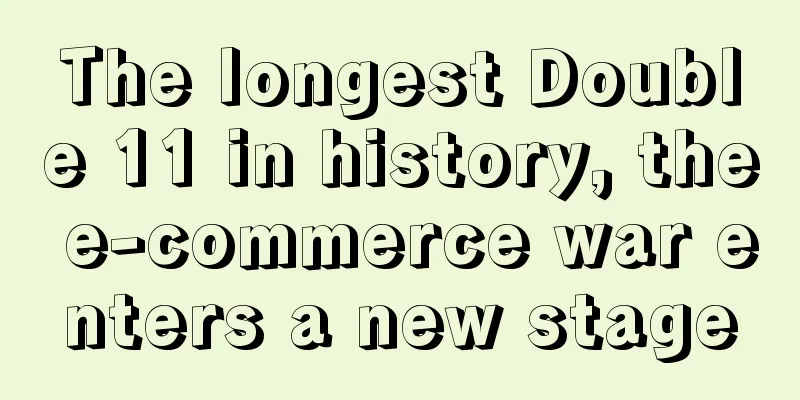Looking at the Customer Selection of Large Models from the Perspective of Communication

“The general big model is self-congratulatory,” said one executive. Recently, I talked with some B2B managers and marketing managers about their views on the practical application of large models and public relations and communication. Surprisingly, many people were critical of the practices of large model companies. for example: After these companies release a new model, they often quickly organize a press conference to try to generate quick attention, and then cooperate with self-media to carry out a series of public relations activities. But the problem behind this is that although everyone has heard of your big model, it is difficult to understand what value this model has, how it can help the customer's business, or which specific scenarios it is applied to and how it can bring benefits to the business. These questions made me start to think, is it that public relations is losing its communication effect, or is it that the big model company simply does not use public relations means well to find customer choices; or is it that the big model is not positioned well and it is a false joy? 01Data, of course it is data, right? But what kind of data do we need? OpenAI originally had nearly one trillion words of data, but they did not use so much directly because they found that the quality of data directly grabbed from the Internet was not good. a) Filtered online data b) Web Text2 dataset c) Library No. 1 Data d) Library No. 2 Data e) English Wikipedia When you start using GPT, you’ll think it’s really powerful and seems to know everything. But if you’ve learned professional artificial intelligence prompts and ask it in-depth industry questions, you’ll find that its answers are sometimes too general, like empty talk. Because it does not have a deep understanding of professional fields, the application scenarios of general large models also remain "general". This is why we still need more professional knowledge to assist decision-making or answer some in-depth questions. Then the question is, if general knowledge does not have depth, what about professional fields? 1. Not understanding the company’s needsWe are a B2B company and in order to gain a competitive advantage, we must build barriers. In the field of data security, we have achieved good results and have been involved in many fields such as automobile companies, education and medical care. For each customer we serve, they have their own unique data and experience, and this information is a valuable asset that cannot be made public casually. This creates a problem: companies that provide large models hope to learn from this data to provide better services, but due to security and privacy concerns, many companies do not want to put their data on the public cloud. How to solve this problem? Also, the Chinese cloud market is completely different from the US market. In the United States, public clouds are very popular. Even though IBM acquired Red Hat, the private cloud market is not very large, and many government departments will choose Microsoft and Amazon's public clouds. It’s different in China, where many business owners are very concerned about where data is stored and the interoperability between various data platforms. For example, some B2B companies choose Huawei Cloud, while some B2C companies need to acquire customers and manage private domains, so they usually use Tencent Cloud or Byte Cloud. This means that the potential of China's hybrid cloud and private cloud market far exceeds that of the United States. It is of no use for me to make a general-purpose big model or introduce a general-purpose big model and sell it to them. 2. Not understanding business attributesYou should have seen the funny story about "Baidu" at the beginning. Give the big model a paragraph and ask it to draw a picture for you. For example, Jia Baoyu uprooting a weeping willow tree and Sun Wukong and the three white-bone demons. It can really make up a picture for you out of thin air. These pictures are totally unrealistic, but don't laugh, this kind of imagination is the fruit of wisdom, and there are very few people in China who can achieve Midjourney. However, this is not important for TOC. Problems will arise if this kind of nonsense is put into the company. For example, we want to connect this big model to the company's system to help decision-making, but if there is a problem with the big model data, then there will be problems. For example: Just like the financial industry, imagine using big models to do data analysis and decision-making. It sounds really cool to teach it all the economics books and financial reports. But if a big model gives you an investment suggestion casually, you might want to tune it and tell it that this suggestion is not good, hoping that it can be improved. But the question is, how accurate can this model's suggestion be? Do you dare to use it for investment advice? How can you ensure that the advice is trustworthy? And what if the data it relies on is outdated? Similarly, if I teach all the secret recipes in the field of traditional Chinese medicine to a robot, can it really accurately prescribe medicine for you? Even if it can, would you dare to take it? Therefore, different types of companies and industries have different challenges. These demands are like the customization of SaaS products. If you want more customization, it is better to deploy it privately in the end; if you want less customization, the big model company cannot sell it at a high price. It is worth mentioning that there is also a data issue. As a B-side company, I give my data to a large model company. Even if I sign an agreement, how do I know whether they will use my data to practice and provide services to other companies? Now that user privacy is so strict, this is not just a technical issue, but also involves trust and responsibility. So, while large models are attractive, they also hide many problems. Whenever a company releases a large model, we pay close attention to those companies that still only release general models. "In my opinion, they may not have really integrated into this highly competitive field, or they may just want to test the waters first," said an executive of a B-side company. 02Obviously, this means that there will not be a single public industry-specific model, and many companies will build their own proprietary models. for example: A hospital uses all its case data to train a large model. After training, they will use this model to improve their own business, but will not share this model with other hospitals. A company with thousands of private domain customers will collect and analyze a large amount of user data and purchasing habits. When they have such a large model, even though it can bring huge value to the entire industry, they are likely to choose to keep it confidential and only serve their own business in order to maintain their competitive advantage. As for whether the industry big model is a false proposition, no one has given an answer. However, some bosses believe that companies that make big models have reversed their business logic. On the one hand, from a bottom-up perspective, only companies that have enough data in vertical fields can evolve a large segmented model, and it is a good choice to make industry-wide models based on segmentation. On the other hand, looking from the top down, it is difficult for companies that specialize in training large models to build industry-level models. They need to consider all participants and their needs, which is almost impossible. Because different companies, even in the same industry, may have different operating models, customer bases, and business processes; it is very difficult to create a large model that can meet all these different needs. So, I asked the demand side curiously, what kind of large model is the most needed? I got two points: 1. Professional verticalProfessional vertical, to put it simply, means being particularly good at a specific field or tool and accumulating a large number of customers. for example: Human resources has its own specific system, sales has CRM, and production has ERP. Imagine that your CRM system has served more than 2,000 customers, and these customers are spread across multiple industries such as education, fast-moving consumer goods, supply chain, and hospitals. At this time, what problem does your CRM+ big model solve? In the field of education, it can deeply analyze students' learning data, classroom feedback, etc., help teachers give more targeted teaching suggestions, and develop appropriate learning plans for students. When it comes to supply chain management, big models can track the flow of goods and inventory status in real time, predict market demand, and optimize inventory and adjust logistics plans for enterprises. A bit like software services such as Youzan SaaS, the big model plays a bridging role here. It not only connects data from various industries, but also ensures that these data provide valuable information for model training . In this way, the big model can tailor solutions for various professional fields to meet real business needs. 2. Marginal specializationWhat does it mean? You are very professional in a specific application or field. That is, it is deeply optimized for a specific environment and special requirements. for example: You have a company that designs and manufactures drones specifically for mountainous areas. These drones are specially optimized for high altitude, low oxygen and low temperature environments, allowing them to work more stably and efficiently in harsh environments. Ordinary drones may encounter problems such as unstable flight and fast battery consumption in such an environment, but your drone data model can cope with these challenges well because it has been specially designed and adjusted. To put it simply, it's like you have all kinds of shoes at home, but if you want to hike, you will choose professional hiking shoes instead of a pair of ordinary sneakers. This pair of hiking shoes is designed for mountain walking and has better grip, support and waterproof functions. To put it more bluntly, most of the large models on the market are "all-rounders" that can process text, pictures, conversations, etc. But if you specialize in text and focus on a specific field such as education or medicine, and then further focus only on academic research, then your model will be like a precise sniper, and its value and effect will far exceed those "big and comprehensive" models. It is worth mentioning that they also mentioned that there are many opportunities for enterprise verticalization. That is to say, if a company is particularly successful in a certain field, it must not only focus on this field, but also incorporate the company's unique experience and knowledge into it, similar to a Michelin three-star restaurant. It not only won three stars because of its cooking skills, but also because it perfectly combines unique experience and knowledge such as special cooking techniques, raw material selection, dish creativity, and service, which makes it stand out among many restaurants. After listening to this, I suddenly realized that companies don’t need generalists, they need specialists. This is somewhat similar to the basic logic of TOB doing SaaS in the past few years. If you understand this, you can think about whether the big model public relations communication has lost its effect or is not used well. 03Public relations, commonly known as Public Relations, what exactly does it do? As the name implies, it refers to the relationship between brands and various stakeholders in the public. These stakeholders are not only consumers, but also governments, non-profit organizations, investors, corporate employees, etc. Simply put, public relations is about "building relationships" and "effectively delivering information." But communication is not just about talking. More importantly, it is about being able to convey the right information at critical moments, so that people can understand what the big model company is doing, what value it has, and how customers can find you. Note that it is "effective and correct". From the perspective of the big model, it can usually be divided into four communication methods: commentary, position, news, and education. Among them, reviews are comments on a certain large model company, event or person, providing an evaluation or opinion. Positions are more from the media perspective, expressing the views of a person or organization, usually targeted. News focuses on reporting facts and events, with the aim of providing the public with objective, timely and accurate information. These three methods are currently classified into one category and are more commonly used. Although they are the most common and versatile forms of public relations at present, their value is also the lowest. After all, they only involve the dissemination of basic information and do not provide more in-depth additional value to the demand side. An executive around me mentioned that he paid attention to DingTalk’s upgrade conference a few days ago. The theme was “Riding on the Back of AI” and the conference was very well done. But after the press conference, he felt somewhat troubled by various self-media reports, and as a result, he unfollowed several well-known public accounts within one day. I asked curiously, “Why do you do this?” He explained that mainstream media platforms would definitely report on an important press conference, and self-media platforms also followed suit to catch the attention, but few of them actually brought incremental value to B-side users, which made him feel very bored. Therefore, for the demand side, what they really care about is "educational" content. In actual applications, educational public relations is further divided into interactive and persuasive types, these two types are often overlooked in communication. "Education" is about delivering knowledge, skills, and information about how to use a tool. The core here is to help me understand the cognition I need to change, what insights you provide me, and how to help the business reduce costs and increase efficiency. "Interaction" pays more attention to two-way communication with the demand side. This means that companies that develop large models need to be more down-to-earth, find customers like me, collect feedback, build relationships, and even create a platform or channel for us to discuss in a community. As for "persuasion", this is relatively easy to understand. It is mainly to promote products or services, with the purpose of influencing my decision or purchase behavior. I understand. 04So, does it mean that self-media does not have the ability to write various in-depth content? In fact, since it is difficult for them to obtain in-depth information about companies, they can only choose to write "review-type" articles from an industry perspective. for example: Some technology bloggers around me will immediately pay attention to the new big models released by big manufacturers. They mainly start with the functions and usage methods, but they can't get the deeper thinking about why the product is made. Just like the "Xiaomi foldable screen mobile phone" some time ago, if Lei Jun didn't mention the dragon bone scroll, the self-media would not know about this thing, nor would they know how difficult it is to produce? What is the difference with other competitors? These things happened to involve patented technologies and confidentiality agreements, so they couldn't be disclosed in the early stages. When they could be disclosed, there was no team that could simply explain it all, which resulted in customers only having a superficial understanding of the motivations. If you understand this, you will also understand what kind of information dissemination is needed from the perspective of the demand side. Simply put, there are three aspects: 1. Tell us what you haveAn executive close to me said that some large model companies, in order to appear to have strong technical capabilities, pile up all kinds of professional terms, such as language technology, multimodal capabilities, and cross-learning. These high-sounding words dazzle many people. This approach may seem to have earned the company some reputation for "technological leadership", but in the long run, this incomprehensible technology stacking is not conducive to product promotion and user acceptance. Think about it, I am considered a highly educated person and I can understand it, but the directors under me may not understand it. This means that information gaps will keep them out, and when they discover a tool that, while useful, is so complicated to truly understand what it is, they may choose to give up. In fact, technology giants should simplify complex technologies so that ordinary users can easily get started. Only when ordinary people can get started can companies cite them, instead of just focusing on showing how advanced their technology is. 2. How to use it with a group of peopleThe so-called "how to use" focuses on a complete set of user operation processes, just like SOP. Take SCRM as an example: When we consider integrating the big model, we need to keep in mind that although we serve B-side clients, some of whom have millions of active users on WeChat for Business, this does not mean that every private domain operator of our clients can freely communicate with community users or distribute information in multiple communities. Therefore, we need to build a clear set of SOPs. In this process, if operators encounter problems when writing copy, they can use the knowledge base of the big model to optimize the copy and simplify the operation so that novices can quickly master it. Taking the medical industry as an example, when providing remote medical services to patients, doctors may rely on a diagnostic assistant software based on a large model. This software not only provides general medical query functions, but also deeply assists doctors in the diagnosis process. When doctors are faced with certain rare diseases or complex symptoms, in addition to relying on their own experience, they can also use this software to compare with existing medical databases to make a more accurate diagnosis. Therefore, only by solving the problem of how a group of people can use it can large model companies have more data and do better. 3. What do I need to change?One executive said, "I always believe that the success of big models and B2B products are similar, and both require finding the right entry point. This entry point is exactly how to make the 'business process' more efficient." For example, a client who is a large beverage manufacturer often encounters problems of unstable inventory, stockpiling by middle agents, and terminal channels during their production and distribution process. If the big model can drive supply chain production based on historical purchases, store sales, and market fluctuations, it can accelerate the speed of bringing new products to market and improve market competitiveness. However, where should this big data model be built? What are the key data? How to provide this data for the model? Which departments need to cooperate? These are not simple questions. Therefore, it is necessary to integrate into the business process to realize the real value. In summary: Large model, lots of room to go. In the next five years, perhaps all tools will be equipped with big models, such as SCRM+AI, ERP+AI, OA+AI... Author: Wang Zhiyuan; Public account: Wang Zhiyuan; |
<<: Movie marketing is not about putting all your eggs in one basket
>>: Who is changing "Jinjiang Literature"
Recommend
How to conduct a large-scale sales meeting?
It's the end of the year, and there is still s...
User retention analysis: improve user stickiness and increase user life cycle value
The article explores the importance of user retent...
The market offers free cooking services! A number of restaurants are completely panicked...
Recently, the vegetable market has evolved and lau...
Is it easy to do e-commerce on Amazon now? Detailed answer
For e-commerce, you can consider domestic platform...
AARRR Model (IV) - Increasing Revenue
The AARRR model was proposed by Sean in his book G...
What are the requirements for registering an Amazon store? What are the conditions for opening an Amazon store?
Although the competition on the Amazon platform is...
How long does it take for an Amazon account to be discovered? Can the association be restored?
Amazon's cross-border e-commerce platform has ...
The life and death of new consumption: price war, franchise competition, and profit protection | Please answer 2023
In 2023, young people are no longer brainwashed by...
How can I place an order on the Wish platform? What should I do if there is no product after placing an order?
It is actually quite easy to place orders on the W...
The latest version of WeChat has updated these major features
This is the first update of WeChat in 2024, and it...
Pinduoduo Temu European semi-hosted merchants product delivery & inventory & shipping template operation
After Pinduoduo's Temu semi-hosting model beca...
In 2024, who will still be shopping in the live broadcast rooms of big anchors?
This year, the popularity of major live-streaming ...
How to transfer warehouses on Amazon? How to calculate the transfer fee?
When running an Amazon store, if there is too much...
Ozon launches new payment method Lianlian cross-border wallet
Ozon announced the launch of a new payment method ...
The story of the snail noodle stall owner's rise to fame: a "Oh" resounded across Douyin, tens of millions of likes, and millions of followers
This article introduces Niu Fuxiang's experien...









